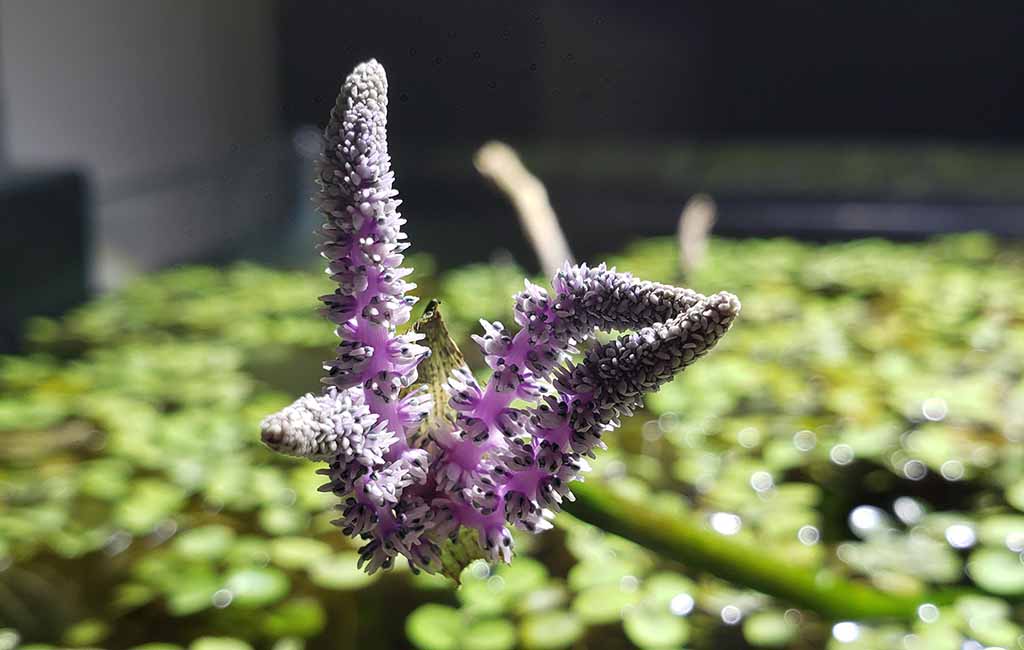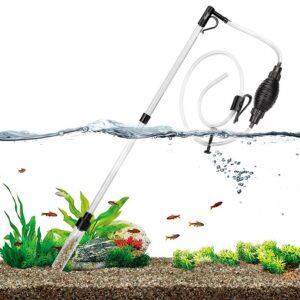Did you catch the beauty of the Madagascar Lace plant? The beautiful and distinguished appearance of this plant with its finely divided feathery lace-like leaves will surely bring elegance into any aquarium.
Content Table
New owners of the plant may also consider Madagascar lace care and the hurdles it comes with most of the time. This article will contain all the necessary information needed for keeping and caring for your Madagascar Lace plant, ranging from basic and complex methods of aquascaping.

Madagascar Lace leaf
Madagascar Lace Plant
To be more precise, the Madagascar Lace plant is scientifically called Aponogeton Madagascariensis and is an exceptional aquatic plant indeed. The Madagascar Lace plant is most suitable as an aquarium plant because of its beautiful appearance and easy maintenance.
Family
It falls under the Aponogetonaceae family with other water plants, such as Aponogeton crispus. This family is a rather large group of aquatic plants, which includes mostly the species from Africa, Madagascar, and Australia.
The floating flowering plants of the family Aponogetonaceae have rather peculiar flowers; the flowers occur in dense spikes arising from the water surface. These could at times be very flashy and could produce both male and female flowers at the same period.
Features
- Unique Leaf Structure: One aspect that stood out to me is the fact that the leaves were fenestrate, which means they were riddled with holes or were lacy in appearance. This adaptation is useful to the plant in its natural environment, since low light intensity is obtained there.
- Bulbous Growth: It starts with a bulbous body, which contains food substances in it and enables the plant to withstand harsh conditions.
- Flowering: The plant has specific flower heads which float on the water surface with their elongated stalks. These spikes bear both sexes of flowers, i.e. male and female flowers.
Origin and Habitat
- Native to Madagascar: As its name implies, it is native to Madagascar and nicely adapted to sluggish, eutrophic waters.
- Habitat: It enjoys areas of moderate light, which could be either sandy or even muddy grounds.

Madagascar lace flower
Madagascar Lace Plant Out of Water
There is a common question asked by the aquarists: “Can Madagascar Lace Plants grow out of water?”
No, Madagascar Lace plants are strictly aquatic and cannot survive out of water. They are not like some other aquatic plants that can transition between aquatic and terrestrial environments.
Key points to remember
- Aquatic Nature: The Madagascar Lace plant is a true aquatic plant, meaning it requires constant submersion in water to survive.
- No Terrestrial Phase: Unlike some other aquatic plants, it does not have a terrestrial phase or a resting period out of water.
- Sensitive to Drying: Removing the plant from water, even for a short period, can lead to significant stress and potentially death.
Maintenance Conditions for Madagascar Lace Plants in Aquariums
While the Madagascar Lace plant is a beautiful addition to any aquarium, it does require specific care to thrive:
- Water Parameters:
| Temperature: 72-78°F (22-26°C) | pH: 6.0-7.5 | Water Hardness: Soft to moderately hard |
- Lighting: Moderate to high intensity is desirable for the best development of the plant and bright coloration.
- Substrate: A nutrient-dense surface is ideal because the plant draws nutrients through its root systems.
- Water Flow: Moderate water flow also benefits the plant by assisting in day-to-day nutrient intake while discouraging algae from latching on to the plant.
- Fertilization: This is because the plant requires time to time supply of nutrients, so freedom fertilizing is a process done to ensure that the plant is supplied with nutrients on time.
- CO2 Injection: Although it is not essential, CO2 injection substantially improves growth and health.

Madagascar lace care
Your Madagascar Lace Plant Care
The Madagascar Lace plant is a stunning addition to any aquarium, but it does require specific care to thrive. Here’s a breakdown of its needs.
Water Parameters
- Temperature:65-74°F (18-23°C) is ideal. However, during its summer resting phase, it can tolerate slightly warmer temperatures of 76-82°F (24-27°C).
- pH of 5–7.5 is suitable.
- Water Hardness: Soft to moderately hard water is best.
Lighting
- Moderate to High: The plant requires sufficient light for optimal growth.
- Light Spectrum: A balanced spectrum, including both red and blue wavelengths, is beneficial.
Substrate
- Nutrient-Rich: A nutrient-rich substrate is essential for the plant’s health.
- Fine-grained: A fine-grained substrate, like aquarium sand or fine gravel, is ideal.
Fertilization
- Regular Fertilization: Basically, fertilization should be a routine process and more especially during the growth periods.
- Liquid Fertilizers: Fluid fertilizers are suitable in nutrient supply to plants as they are easy to use and applied with ease.
- Root Tab Fertilizers: Root tab fertilizers can also be used to replenish the nutrient supply for plants in the substrate.
Water Flow
- Moderate Water Flow: Moderate water flow helps to keep the plant healthy and prevents algae growth.
CO2 Injection
- Optional but Beneficial: While not strictly necessary, CO2 injection can significantly boost growth and health.
Special Considerations
- Resting Phase: It is worthy of note that the Madagascar Lace plant is dormant in the summer. At this time, the plant might lose its leaves and may not appear to be growing or alive at all. During this period, one should increase water temperature by a degree or two and dim the light.
- Flowering: It may not always happen, but if all the conditions are met – light, a favorable temperature range, sufficient nutrients, and water flow – the plant will start flowering.

Madagascar Lace aquarium
The Secrets of Madagascar Lace Plant
Madagascar Lace plant, scientifically known as Aponogeton madagascariensis, is an exciting aquatic plant that has a beautiful lace-like texture of the leaves. While it is apparent that it looks great, several interesting facts have been withdrawn behind the great cover.
A Seasonal Spectacle
- Summer Slump: Compared to most water plants, the Madagascar Lace plant is summer-dormant. It may lose its leaves, or for some time seem to be a withering plant during this period.
- Autumnal Revival: The plant may die back during the cold season and grow again in another season with leaves touched with bright colors.
The Secret to Flowering
- Nutrient-Rich Environment: To encourage flowering, it must be supplied with the right nutrients, such as iron and potassium.
- Optimal Water Conditions: Assure optimal water conditions in water parameters such as water temperature, the water acidity level, and water hardness.
- Adequate Lighting: Top up the plant with adequate light to allow for growth as well as blossoming.
A Hardy Survivor
- Resilient Nature: The Madagascar Lace plant is quite frail-looking but is, in actuality, very tough. It can adapt to a broad host of water quality factors.
- Bulbous Reserve: Due to its bulbous nature, the plant can contain the energy and nutrients needed to survive times of stress.
A Challenge for Beginners
- Demanding Care: Although very rewarding to grow, the Madagascar Lace plant proves to be a bit difficult for individuals who are new to the practice of aquascaping.
- Sensitive to Changes: Water changes must be slow since the plant reacts adversely to any changes in water table conditions.
A Unique Leaf Structure
- Fenestrated Foliage: The plant has specific lacy leaves due to the specific structure of the leaves. The holes or perforations in the leaves enable the improvement of light transmittance and gas interchange.

Madagascar lace plant
How to Plant Madagascar Lace in an Aquarium
- Prepare the Substrate: Select a nutrient-rich substrate such as the aquarium sand or a specific plant substrate cooperative with your local store. Make sure it is not dirty or full of lots of dirt and debris.
- Plant the Bulb: Take the Madagascar Lace plant bulb and place it on the substrate in the bowl in such a manner that it will only be slightly covered by the substrate.
- Secure the Bulb: To assist in anchoring the bulb, use aquarium gravel or small rocks that would ensure the bulb does float.
- Position in the Tank: Put the planted bulb in a proper position inside an aquarium environment as mentioned earlier. One has to think about the amount of light that is introduced and the flow of water.
- Monitor and Adjust: Take time to monitor the plant in the first days or weeks, depending on its growth rate. Sometimes, it can be fixed in position or water parameters to allow its growth to be optimal.
Conclusion
This aquarium plant called Madagascar Lace has a stunning appearance with a delicate leaf pattern. Although it may call for special attention, its natural beauty and ability to survive complications make it an excellent hobby for fish keepers. Knowing the needs of this water creature and creating the best conditions, you can observe the miraculous beauty of these aquatic plants.


Leave a comment